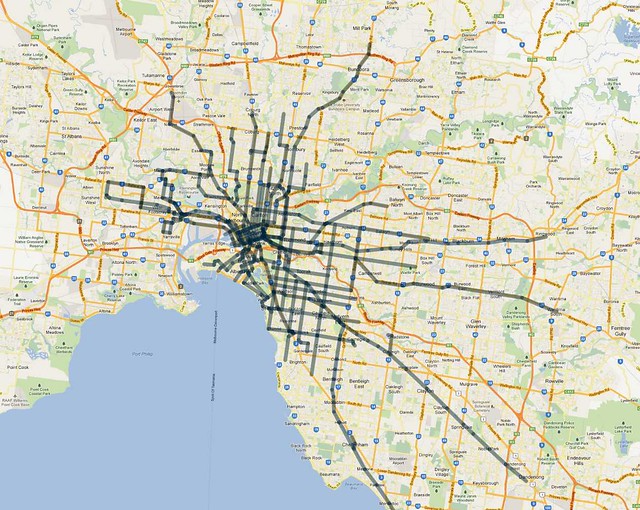A study of Melbourne public transport timetables shows much of the city is still lagging on providing frequent, easy-to-use services that will encourage people out of cars.
PTUA outgoing president Daniel Bowen said that the study confirmed what most Melburnians think – that trams run frequently, trains are a mixed bag, and that most buses do not offer the type of frequent service that makes them a competitor to car travel — forcing most households in middle and outer Melbourne to be car-dependent.
“Frequent services are critical to getting people out of the traffic”, said Mr Bowen. “People don’t want to live their lives by timetables. They want to get to the stop or station when it’s convenient for them, and not have a long wait. And if they have to change services on the way to their destination, they want to keep moving without a long wait for a connection.
“That’s why the biggest world cities provide networks of frequent services, seven days-a-week, across the suburbs.
“It’s also why Melbourne’s trams, trains and the few frequent bus routes have booming patronage, getting cars off the road, but bus routes with poor service are mostly used only by those who don’t have a choice.”
The study looked at which routes run frequently (every 15 minutes or better), and compared peak times, off-peak (weekdays), weekend and evenings. Where appropriate it considered corridors where multiple services run to provide a higher frequency, such as St Kilda Road’s trams.[1]
During peak times, 97% of tram routes run frequently[2], 79% of train lines, and 21% of buses routes run every 15 minutes or better.
At off-peak times, 90% of trams, 46% of trains, and 13% of buses met the 15 minute threshold.
On weekends during the daytime, 90% of trams run frequently, 29% of trains, and just 2% of buses [3]
In the evenings almost no public transport corridors run every 15 minutes; just 10% of trams, 4% of trains, and 0.3% of buses.[4]
Maps of the four time periods show, particularly outside peak times, vast areas of Melbourne without frequent services.
The findings were that since the last study in 2006, the number of frequent train lines has increased, trams have decreased slightly thanks to the introduction of some peak-hour only routes, and buses have jumped thanks to the rollout of Smartbus routes, but are still have the lowest proportion of routes running frequently.
“Trains and trams get plenty of use, even late at night. Even those bus routes that have upgraded to Smartbus are very popular. More are needed to ensure more of Melbourne has a genuine alternative to car travel.
“Most of Melbourne has only buses every 30 to 60 minutes. This has to improve to help get more people out of the traffic, cut congestion, and reduce the impact of rising fuel prices.”
The PTUA campaign Every Ten Minutes To Everywhere advocates a backbone network of trains, trams and Smartbuses, providing every Melbourne suburb with frequent services, every day of the week until midnight, ensuring that people can get from anywhere to anywhere in Melbourne easily by public transport.[5]
“If the government is serious about keeping Melbourne moving, they need to provide a simple to understand, frequent public transport network to all of Melbourne”, concluded Mr Bowen.
* * *
[1] The study looked at all tram, train and bus services accepting Metcard and Myki tickets, with the exception of V/Line services within the suburban area. It looked at “typical” frequencies during peak hours, in the middle of the day on weekdays (“off-peak”), at 10pm on weekdays (“evenings”) and on Saturday and Sunday afternoons.
Multiple routes were considered as one corridor where the PTV listed them as “combined” (eg bus routes 216 and 219), where times were listed together in timetables (eg the Frankston, Pakenham and Cranbourne lines between the City and Caulfield), and a small number of lengthy sections where multiple tram routes run together and provide frequent service (eg St Kilda Road).
The orbital Smartbus routes were considered as multiple separate routes if they were listed in sections in the printed timetables, thus 901 Frankston to Melbourne Airport counts as 5 routes. This reflects that they are primarily used for short trips, that they replaced multiple routes and that they provide lengthy sections of frequent service.
[2] At peak times almost every tram route runs frequently, but the City Circle has no service during morning peak. At off-peak times, some peak-only routes do not run.
[3] On Saturdays 2.0%, on Sundays 0.8%
[4] However most tram routes run every 20 minutes in the evening from Monday to Saturday, substantially better than most trains and buses.
[5] www.ptua.org.au/campaigns/every10minutes/
* * *
Summary of results:
Number of services every 15 minutes or better
2012:
| 2012 | Peak | Off-peak | Weekend | Evening |
|---|---|---|---|---|
| Train | 79.2% | 45.8% | 29.2% | 4.2% |
| Tram | 96.7% | 90.0% | 90.0% | 10.0% |
| Bus | 20.9% | 13.1% | 2.0% | 0.3% |
| Overall | 29.9% | 20.6% | 9.5% | 1.2% |
2006:
| 2006 | Peak | Off-peak | Weekend | Evening |
|---|---|---|---|---|
| Train | 66.7% | 41.7% | 12.5% | 12.5% |
| Tram | 96.6% | 93.1% | 93.1% | 10.3% |
| Bus | 12.0% | 6.3% | 1.3% | 0.3% |
| Overall | 22.7% | 15.9% | 9.6% | 2.0% |
(Original 2006 study is here.)
Maps
Every 15 minutes or better, peak hour, 2012:

Every 15 minutes or better, weekday off-peak, 2012:

Every 15 minutes or better, weekends (Saturday), 2012:

Every 15 minutes or better, evenings (10pm), 2012:

Underlying maps copyright Google.
- See also: Herald Sun 3/10/2012: Peak public transport not frequent enough to get Melbourne drivers to switch – Public Transport Users Association study

